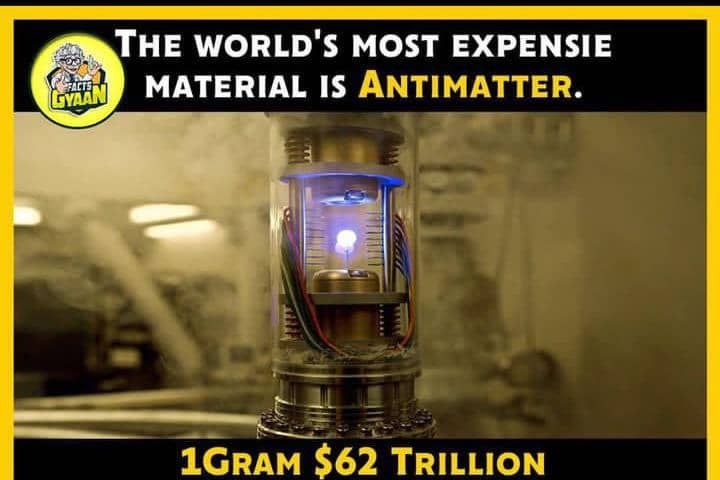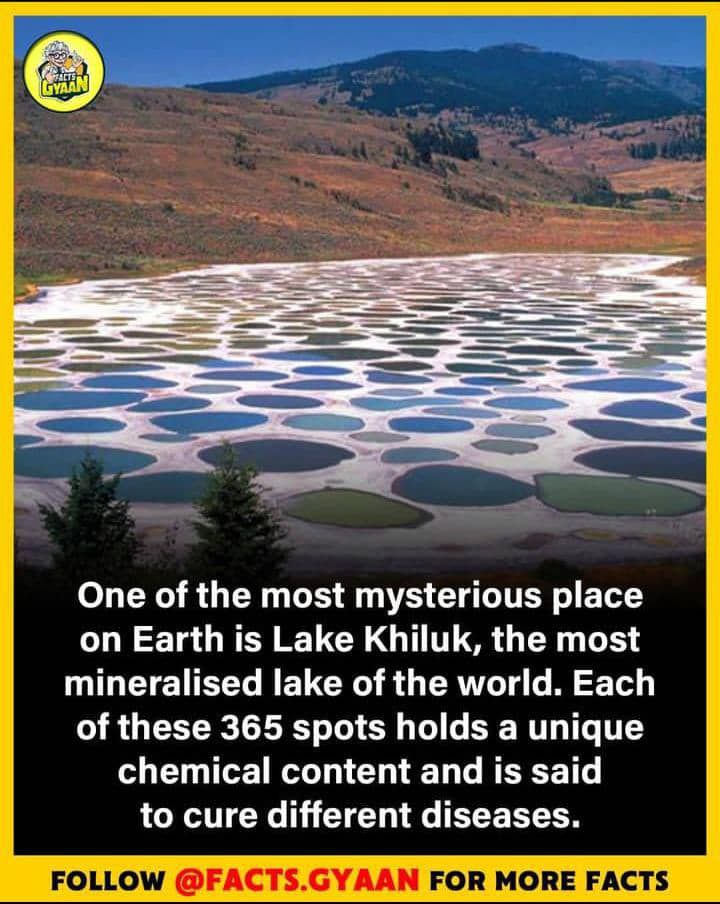Facts – World Most expensive Material “AntiMatter”

At present, antimatter costs $62.5 trillion per gram. Projected improvements could bring this cost down to $5 billion per gram and the production level up ten times from 1.5*10^-9 to 1.5*10^-8 grams (from 1.5 to 15 nanograms). antimatter was difficult to be created at the very early times of the Universe, the reason is still unknown… Obviously we live in a “matter” world with a low \% of antimatter, meaning that for some reason at some point matter was preferentially produced compared to antimatter…This goes around as matter-antimatter asymmetry. What is antimatter? Most people know that the basic nuclear particles that make up matter are protons, electrons, and neutrons. In 1930, Paul Dirac developed a description of the electron, which also predicted that an antiparticle of the electron should exist. This antielectron (also called a positron) was predicted to have the same mass as the electron but an opposite electric charge. Later, it was discovered that the other basic atomic particles had antimatter counterparts, the antiproton and the antineutron. When a particle and its antimatter counterpart meet, they are both annihilated, which means that the two particles disappear and their mass is converted to energy, following the principle embodied in Einstein’s famous equation E = mc2. As you may well know, “c” in this equation is the speed of light, which is a large number. Because this number is squared, this means that a small amount of mass can be converted to an enormous amount of energy. To give you an idea of how much energy is evolved during a matter/antimatter annihilation, this reaction is considered to be 100,000,000,000 times more powerful than a typical chemical explosion such as trinitrotoluene (TNT) and 10,000 times more powerful than a nuclear explosion. How can you create antimatter? To actually create antimatter, scientists focused on the simplest form of matter, hydrogen. A hydrogen atom consists of just one electron and one proton. This means that the simplest form of antimatter, an antihydrogen, is made up of an antiproton and a positron. The positron is attracted to an antiproton in the same way an electron is attracted to a proton. The first antihydrogen was made in 1995 at the CERN (European Organization for Nuclear Research) super collider by colliding antiprotons with xenon atoms. This collision produces a positron, which is electrically attracted to another antiproton, subsequently forming antihydrogen. Unfortunately, it only takes a few millionths of a second for antimatter particles to come into contact with their matter counterparts, annihilating themselves and giving off energy. Because of this, scientists have worked on ways to make antimatter stable enough to be contained. The key was to slow the antihydrogens to keep them from colliding, and this was achieved by containing the antimatter in a bottle at just half a degree above absolute zero, the theoretically coldest achievable temperature. In 2011, scientists were able to hold produced antihydrogen for over 15 minutes using this method. Why are the costs so high? The reason for antimatter’s tremendous expense is easy to understand when you realize the technology involved in creating it. To make antihydrogen, the required antiprotons must be literally made one atom at a time using a particle accelerator. The CERN super collider is the most complex piece of machinery every constructed by humans. It took about a decade to construct, at a cost of about $4.75 billion. It is roughly 10 miles across and contains 9300 magnets, all of which must be super cooled to − 456.25° F using liquid helium. For the collision to occur, the particles are accelerated to 99.99% of the speed of light, which requires an incredible 120 MW of electric power, enough to power a large city. The collider has a total operating budget of about $1 billion per year, with electricity costs alone running at $23.5 million per year. When you also consider the fact that it has been estimated to take 100 billion years to produce 1 g of antihydrogen, you begin to see why the costs are so high.
Facts – The Sony Play Station as a Console

The first PlayStation was originally conceived as a result of a 1991 partnership between Sony and Nintendo. Nintendo wanted to release a CD-based add-on console for the Super Nintendo Entertainment System (SNES) at the time, and enlisted Sony to develop the machine. However, the partnership failed, and Sony began developing the PlayStation after the failed venture with Nintendo to create a CD-ROM peripheral for the Super Nintendo Entertainment System in the early 1990s. The console was primarily designed by Ken Kutaragi and Sony Computer Entertainment in Japan, while additional development was outsourced in the United Kingdom. Sony released the first PlayStation console in December 1994. The PlayStation (abbreviated as PS, commonly known as the PS1/PS one or its codename PSX) is a home video game console developed and marketed by Sony Computer Entertainment. It was released in Japan on 3 December 1994, in North America on 9 September 1995, in Europe on 29 September 1995, and in Australia on 15 November 1995. As a fifth-generation console, the PlayStation primarily competed with the Nintendo 64 and the Sega Saturn. Sony began developing the PlayStation after a failed venture with Nintendo to create a CD-ROM peripheral for the Super Nintendo Entertainment System in the early 1990s. The console was primarily designed by Ken Kutaragi and Sony Computer Entertainment in Japan, while additional development was outsourced in the United Kingdom An emphasis on 3D polygon graphics was placed at the forefront of the console’s design. PlayStation game production was designed to be streamlined and inclusive, enticing the support of many third-party developers. The console proved popular for its extensive game library, popular franchises, low retail price, and aggressive youth marketing which advertised it as the preferable console for adolescents and adults. Premier PlayStation franchises included Gran Turismo, Crash Bandicoot, Spyro, Tomb Raider, Metal Gear, Tekken, and Final Fantasy, all of which spawned numerous sequels. PlayStation games continued to sell until Sony ceased production of the PlayStation and its games on 23 March 2006—over eleven years after it had been released, and less than a year before the debut of the PlayStation 3. A total of 3,061 PlayStation games were released, with cumulative sales of 967 million units. The PlayStation signalled Sony’s rise to power in the video game industry. It received acclaim and sold strongly; in less than a decade, it became the first computer entertainment platform to ship over 100 million units. Its use of compact discs heralded the game industry’s transition from cartridges. The PlayStation’s success led to a line of successors, beginning with the PlayStation 2 in 2000. In the same year, Sony released a smaller and cheaper model, the PS one.
Facts – The Spotted Lake of British Columbia,Lake Khiluk

Lake Khiluk also known as Spotted Lake (Kłlil’xᵂ) is a saline endorheic alkali lake located northwest of Osoyoos in the eastern Similkameen Valley of British Columbia, Canada, accessed via Highway 3. Originally named in the Nsyilxcən language of the Syilx First Nation of the Okanagan Valley as Kłlil’xᵂ, Spotted Lake was for centuries and still remains revered as a sacred site thought to provide therapeutic waters. During World War I, the minerals of Spotted Lake were used in manufacturing ammunition. Yes, this place actually exists and it’s just another example of how weird and wonderful nature can be – who can make this stuff up? Let’s look at some facts you need to know about this magical place! Lake Khiluk is the most mineralized lake in the world. Each spot holds a different cure due to the unique chemical content found within each puddle. It’s located in British Columbia, Canada, northwest of the town of Osoyoos. The lake measures 0.16 miles (.25 km) wide by 0.43 miles (.7 km) long with a combined shore length of just over one mile (1.7 km). According to the First Nations Okanagan (Sylix) tribe, Lake Khiluk is a sacred place of healing. The Okanagan tribe used the water in the spots to treat conditions such as warts, skin disease, body aches, and battle wounds Lake Khiluk is considered a saline endorheic alkali lake. According to Wiki, “An endorheic basin is a closed drainage basin that retains water and allows no outflow to other external bodies of water, such as rivers or oceans, but converges instead into lakes or swamps, permanent or seasonal, that equilibrate through evaporation.” So what’s left at the end of the evaporation are spots or puddles of highly concentrated minerals. During the summer, most of the water evaporates from the lake, leaving the colorful spots of minerals. The lake bottom around the spots dries and hardens forming natural paths throughout the lake. The colors of the spots change with the time of day and seasons The most predominate mineral found in the spots is magnesium sulfate. There are plenty of calcium and sodium sulphates too. Scientists have identified eight other minerals present in some of the spots. Four more minerals were found in lesser quantities, among these four are silver and titanium. During World War I ammunition was made using minerals from Lake Khiluk ,The land used to belong to the family of Ernest Smith but after many years of haggling, the First Nations tribe was able to purchase the land. Their goal is to preserve it as a sacred healing site.
